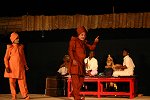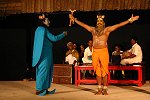The Tamil Nadu Kattaikkuttu Kalai Valarchi Munnetra Sangam is a grassroots organization that promotes the cultural and economic rights of professional Kattaikkuttu performers. It was established in 1990 by a group of seventeen performers belonging to different Kattaikkuttu theatre companies. At present the Sangam has more than two hundred members who live in the northern districts of Tamil Nadu and the Chittoor district of Andhra Pradesh. The Kattaikkuttu Sangam runs the Kattaikkuttu Youth Theatre School, which provides professional Kattaikkuttu training to underprivileged, rural children in combination with basic education. The Sangam provides a framework within which performers can discuss their professional demands and aspirations. It produces new plays, organizes theatre and other creative workshops, in addition to an annual Kattaikkuttu Festival.
The Kattaikkuttu Sangam is the organizer of the Kuttu Festival 2005 through which it wants to celebrate, together with other performers and its regular audiences, the fact that the organization exists fifteen years. For this special occasion a group of thirty-five performers who act in the nine different Kattaikkuttu performances put up by the Sangam, in addition to co-organizing the event. They special performance group represents actors and musicians drawn from two important Kattaikkuttu styles, that from around Kanchipuram-Cheyyar and that found in the Gingee-Vilupuram area.
During the second half of the nineteenth century a number of novel forms of theatre emerged in different regions of India. These incipient theatres were the result of the colonial encounter and the social-economic, political and psychological effects this brought in its wake. They were hybrid in form and content, combining elements from the indigenous theatres with melodramatic performance conventions and proscenium stage techniques gleaned from the Western Victorian stage. Their repertoires included plays based on the Indian epics and puranas, in addition to translated versions of the plays of Shakespeare and Molière and stories taken from Thousand-and-One Night. These hybrid theatres were also India's first commercial theatres. They operated outside the rural, feudal and courtly contexts in which traditional theatres had flourished and they used newly available techniques, such as electric lights and printed play-announcements, to promote their performances. In Tamil Nadu one of these novel, hybrid form of theatre was the Isai Natakam, also known as 'Company Drama' or just 'Drama'. The Isai Natakam was the principal means of popular entertainment until the rise of the popular Tamil film. It catered to the demands of rural and urban spectators for 'novelty', the 'exotic' and the 'fashionable' and it was one of the earliest, popular oral and visual harbingers of modernity. With the advent of the Tamil film, the Isai Natakam lost part of its popular patronage. Yet, Isai Natakam performances remain in demand in the rural areas and the poorer parts of Chennai and popular 'Drama companies' do about 150 performances a year.
Members of the Kattaikkuttu Sangam normally perform in Kattaikkuttu style. However, on the occasion of the Festival a few of them who are familiar with this style will perform the play 'The Marriage of Subhadra' in Isai Natakam or Drama style. This performance showcases the interconnectedness of popular theatre genres in the region, which until about fifty years ago were not so clearly demarcated into separate 'styles'. Kattaikkuttu and Isai Natakam, and more recently the popular film, vie for the favours of the same rural audiences. They have been involved in continuous process of imitating successful dramatic elements from each other, while at the same time trying to demarcate their own genre stylistically from the other so as to capture the favours of the local spectators. The Isai Natakam does not use wooden kattai ornaments characteristic of Kattaikkuttu. Instead, the characters wear tunic-like outfits, which are referred to as 'dress'.
2 hours Stylistically the Marriage of Subhadra falls in between a Kattaikkuttu proper and a play in Isai Natakam. It does not have a particularly heroic content and can be performed in both styles. The play places great emphasis on the (musical) rendering of the songs and word-plays, which makes its performance a treat to lovers of music and Tamil.
Duryodhana —insulted that Draupadi ignored him during her svayamvara and married Arjuna instead — decides he wants to get married now. His choice falls upon Subhadra, the sister of Krishna and Balarama. He sends his father's unmarried brother, Vidura, to negotiate and ask for the girl's hand. Balarama, who feels that Duryodhana is a good match, promises to give Subhadra in marriage to Duryodhana, but says that he wants to have a word with his younger brother Krishna. Krishna is aware of the fact that his Subhadra secretly is in love with the handsome Arjuna. Therefore, he embarks on the tricky process of turning around his older brother's promise so as to fulfil his sister's wish. What follows is an intricate sequence of songs involving a game of words between Krishna, Balarama and Vidura, in which only double meanings count.
In the mean time Arjuna sets out in the disguise of a sanyasi (ascetic) on a 'pilgrimage', which involves a number of erotic escapades ending in marriages (in addition to Draupadi and Subhadra, Arjuna also marries the Naga princess Ulupi, the amazone ruler of Madurai, Allirani, Pavalakkoti, Minnaloli and Bhogavati during this time of sexual wanderlust). He arrives at Vadamadurai, the abode of Balarama and Krishna, to perform asceticism. Balarama sends his sister Subhadra to serve the sanyasi. Seeing that the sanyasi's hands are rough and marked by the frequent holding of a bow, she feels that he cannot be a real ascetic but must be Arjuna in disguise. In Balarama's absence, Subhadra and Arjuna elope and get married with the help of Krishna. Once more Duryodhana has been 'cheated' out of marrying the girl he fancied. To keep his promise, Balarama gives his own daughter, Bhanumati, instead of Subhadra, in marriage to Duryodhana.
Tamil Nadu Kattaikkuttu Kalai Valarchi Munnetra Sangam & Kattaikkuttu Youth Theatre School |

